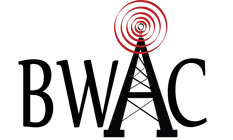The Broadband Wireless Access & Applications Center (BWAC) is a multi-university IUCRC that focuses on addressing fundamental yet industry-relevant research challenges in next-generation wireless systems. The intertwined and multi-faceted nature of such complex systems calls for a diverse range of complementary expertise in antenna design, radio engineering, signal processing, wireless communications, networking, cloud computing, and security, as well as research tools (modeling and simulation, hardware/software prototyping, platform integration and maintenance, and measurements and data curation). The breadth of such a research program necessitates collaboration among multiple research teams and partnering with pioneering private companies and federal agencies in this field.
Inaugurated in 2013, BWAC is now in its second phase (Phase II). It currently includes the following four university sites: University of Arizona (UA), Catholic University of America (CUA), University of Mississippi (UMiss), and North Carolina State University (NCSU). It also has more than 14 membership-paying affiliates from industry and government labs. Each university site brings to the center unique skillsets and strengths. Specifically, UA has significant expertise in 5G/LTE/Wi-Fi wireless protocols, spectrum sharing, mmW systems, and physical-layer security. VT is renowned from its research on security and privacy in dynamically allocated spectrum for heterogeneous wireless technologies. Antenna design at high frequencies is led by the team at UMiss, with supporting expertise from the UA. The CUA team is leading the center's research efforts in MEC and its role in supporting ultra-low-latency communications. UMiss brings valuable expertise in the area of computational electromagnetics, including modeling and simulation of antenna cloaks, supported by fabrication and testing at the UA site. Although each site exhibits critical mass in one or more BWAC thrusts, synergies arise naturally between researchers across different sites due to common interests. Such synergies have been instrumental in enabling collaborations across sites.
BWAC Phase-II research can be categorized into the following thrusts, which have been planned in concert with the Industry Advisory Board (IAB):
Spectrum sharing for heterogeneous wireless systems. Topics include spectrum sensing; interference-mitigation techniques and protocols for coexistence over licensed and unlicensed bands; inter-operator spectrum pooling/aggregation; spectrum sharing under directional transmissions; spectrum economics; and heterogeneous coexistence under full-duplex capabilities.
Secure and private wireless communications. Topics include information-theoretic secret communications; Physical (PHY) layer security; channel-based authentication and fingerprinting; jamming-resistant protocols; rendezvous and network/device discovery under stealth (selective) attacks; hiding of side-channel information; and security in DSA systems.
-
MIMO and signal processing techniques in wireless systems. Topics include precoding in one-to-many (MU-MIMO) systems and peer-to-peer (e.g., mobile ad hoc) systems; MIMO precoding of friendly jamming signals; game-theoretic analysis of distributed mutually interfering MIMO systems; full-duplex MIMO designs; and signal classification;
-
mmW systems. Topics include channel modeling; mmW antenna subsystems and low-power circuits; beam-tracking designs; hybrid analog/digital beamforming; backhauling protocols; distributed scheduling in mmW small cells; user-BS association and handover in a multi-BS mmW systems; and outage-resilient mmW protocols.
-
Collaborative MEC systems. Topics include delay analysis for ultra-latency MEC protocols; energy/Quality of Experience (QoE) tradeoffs; collaboration between edge nodes within a single MEC operator; dynamic network slicing; machine learning algorithms for MEC task assignment; analysis of MEC collaboration via coalition formation games; and privacy-preserving MEC collaboration protocols.

